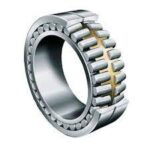A roller bearing is a type of anti-friction bearing that uses cylindrical rolling elements to reduce friction between moving parts. These rolling elements are called rollers, and they provide support and facilitate smooth motion for various machinery components. Roller bearings are widely used in a variety of applications, including automotive, industrial, and aerospace systems.

Here’s a detailed explanation of roller bearings:
Components of a Roller Bearing: A typical roller bearing consists of the following main components:
- Inner Ring: This is the innermost part of the bearing, and it is usually mounted on a shaft. The inner ring is the component that rotates along with the shaft.
- Outer Ring: The outer ring is the stationary part of the bearing, and it is typically housed in the bearing housing or casing.
- Rollers: The rollers are cylindrical-shaped elements that fit between the inner and outer rings. They roll along the raceways (grooved tracks) on the inner and outer rings, allowing for smooth motion.
- Cage: In many roller bearings, a cage is used to separate and maintain equal spacing between the rollers. The cage helps to prevent the rollers from coming into contact with each other, which could cause friction and wear.
Types of Roller Bearings: There are several different types of roller bearings, each designed for specific applications and load conditions. Some common types of roller bearings include:
- Cylindrical Roller Bearings: These have cylindrical rollers and are capable of handling radial loads (loads applied perpendicular to the shaft’s axis). They are commonly used in applications such as electric motors and gearboxes.
- Tapered Roller Bearings: Tapered rollers are used in these bearings, which are designed to handle both radial and axial loads (loads applied parallel to the shaft’s axis). Tapered roller bearings are frequently found in automotive wheel hubs and large industrial machinery.
- Spherical Roller Bearings: These bearings have barrel-shaped rollers and are designed to accommodate misalignment and heavy radial and axial loads. They are often used in applications with oscillating or vibrating motion, such as conveyor systems and heavy machinery.
- Needle Roller Bearings: Needle rollers are slender and cylindrical, making them suitable for applications with limited space and high radial load requirements. Needle roller bearings are used in automotive transmissions and aircraft components.
Advantages of Roller Bearings: Roller bearings offer several advantages over plain bearings (bushings) and other types of bearings:
- Reduced Friction: Roller bearings reduce friction, which results in less heat generation and improved efficiency in rotating machinery.
- Higher Load Capacity: Roller bearings can handle higher radial and axial loads compared to plain bearings.
- Longer Life: Properly maintained roller bearings can have a longer service life, reducing maintenance requirements.
- Precise Motion: Roller bearings provide smoother and more precise motion, making them suitable for applications that require accuracy and reliability.
- Versatility: With various types and sizes available, roller bearings can be tailored to suit a wide range of applications.
In summary, roller bearings are essential components in many mechanical systems, providing support, reducing friction, and ensuring smooth motion. Choosing the right type of roller bearing depends on factors such as load requirements, speed, and environmental conditions in a specific application.